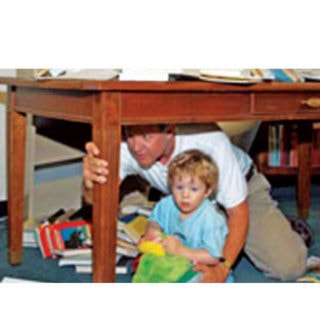What’s shakin’?
Rick McLeod is out pounding the streets.
With fellow Emergency Social Services (ESS) members Emily Locke and Bob Hudson, Sooke’s deputy fire chief is encouraging locals to take part in a drill that could mean the difference between life and death should the streets ever start shaking.
By the time the January 26 rolls around, if McLeod, Hudson and Locke have anything to say about it, there should be very few who are taken by surprise by the district, region, and province-wide exercise.
McLeod told the Sooke News Mirror their goal was to “blanket the community” with awareness of the major effort intended to prepare the populace for the seismic disaster experts have long said is overdue.
All five local schools are to be involved and all will be equipped with radios enabling contact with the Emergency Operations Centre which will be set up in the municipal council chamber.
It’s billed as the largest earthquake drill ever to be held in the province and Rick McLeod said the “Great British Columbia Shake Out” is modeled after a similar undertaking in California back in 2008.
Emergency Coordinator for the Juan de Fuca Electoral Area George OBriain advises that in the Juan de Fuca the following will happen:
a. Tsunami sirens in Port Renfrew will be activated;
b. Radio communications will be activated within the EA and with all schools in Sooke (working in conjunction with District of Sooke);
c. Participate with Otter Point Fire Dept and Shirley Fire Dept in a loud display of vehicle activity throughout the two communities (TBD); and
d. Activating the JdF EOC to level three.
Handouts and posters have been delivered to the seven communities of Juan de Fuca.
There has already been expressions of commitment from more than 54,000 participants in the Capital Regional District as of January 7. Province-wide the number of people expected to be involved was 206,795 as of that date.
The specifics are likely to continue changing as the date draws nearer, but here’s a breakdown of the people in the CRD who had indicated an intention of take part in this month’s quake drill:
• 160 individuals/ families representing 383 people
• 36 schools – 20,742 participants
• two post secondary institutions – 23,250 people
• five registrants affiliated with the federal government – 314 people
• 17 affiliated with the provincial government – 3,402 people
• 13 affiliated with local governments – 2,259 people
• CRD employees – 500 people
• eight businesses – 206 people
• 11 health sector registrants – 868 people
• one museum, library, park – 200 people
• 10 non-profit groups – 451 people
• five preparedness groups – 1,284 people
• two community groups – 450 people.
British Columbians must get better prepared before the next big earthquake, and also practice how to protect ourselves when it happens. The purpose of the ShakeOut is to help people and organizations do both.
• Register yourself or your organization to be counted in the ShakeOut Drill, get email updates, and more.
Between now and January 26:
• Consider what may happen when an earthquake shakes your area. Plan what you will do now to prepare, so that when it happens you will be able to protect yourself and then recover quickly.
•Talk to other people or organizations about what they have done, and encourage them to join you in getting more prepared. Display posters around your community, classroom, or office space and provide flyers for further information.
January 26, 10 a.m.:
1. Drop, Cover, and Hold On: Drop to the ground, take Cover under a table or desk, and Hold On to it as if a major earthquake were happening (stay down for at least 60 seconds).
Practice now so you will immediately protect yourself during earthquakes! See this page for what to do if you have a disability or an activity limitation.
2. While still under the table, or wherever you are, look around and imagine what would happen in a major earthquake. What would fall on you or others? What would be damaged? What would life be like after? What will you do before the actual earthquake happens to reduce losses and quickly recover?
3. Finally, practice what your community will do after the shaking stops.
For more information visit www.shakeoutbc.ca/index.html.
